|
phase change materials and transient loads
in the thermal management field, phase change materials (pcms) have been studied for many years, and they have been put to many uses. they have been used as thermal interface materials (tims), where their phase change characteristics allow them to “wet” a surface when they warm up, conforming to imperfect mating surfaces[[1]]. this gives them excellent performance as a tim, even though the material itself has relatively poor thermal conductivity [[2]].
phase change materials have also been long used for thermal energy storage. this application relies on a completely different property of a phase change material: its latent heat of fusion. as energy is absorbed by a solid material, its temperature rises linearly until it reaches its melting point. to change phases to a liquid, extra energy input is needed, and while the material is absorbing this energy, its temperature remains the same. from a thermal management perspective, this is great, because energy can be dissipated into a phase change material while the cooled object stays at a constant temperature. in many regards, phase change material is the thermal management equivalent of a capacitor in electronics.
of course, this only lasts as long as there is solid material to melt. and, because many commonly used phase change materials conduct heat poorly, that solid material needs to be close to the thermal interface in order to be effective. fleischer, weinstein and kopec performed a study that illustrates that point [3]. in the study, a volume of paraffin wax pcm roughly 70mm per side was used. the sides were insulated, a heat source was applied to the bottom, and the top was covered by a cold plate maintained at 5ºc. in this setup, the heat flux is transferred from bottom to top through the pcm.
five thermocouples were embedded in the pcm to monitor temperatures along the direction of heat flux, as shown in figure 1. thermocouple #3 is at the bottom, #1 is at the top, and #2, 4, and 5 are across the middle.
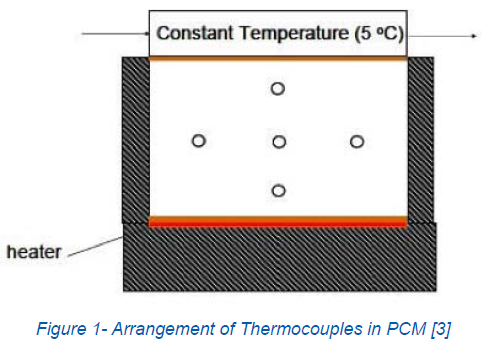
with an applied heat flux of 7 w, a large temperature gradient develops across the pcm, peaking at 38ºc over a distance of about 30 mm between the top and bottom thermocouples. this gradient can be seen around the 5000 second point in figure 2. it can also be seen that it takes more than 3 hours (12000 s) for the melt front to reach all of the thermocouples. at this point, it was found that there were still solid pieces of pcm circulating within the liquid pcm, demonstrating how the low thermal conductivity of the pcm contributed to localized temperature differences.
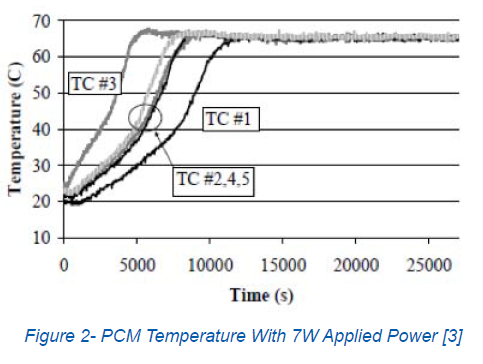
one way to work around the low thermal conductivity is to embed a pcm into substrates with higher conductivity, such as aluminum. the use of aluminum foam filled with pcm (see figure 3) was studied by nasa to provide cooling for led helmet lights on spacesuits [[4]]. a particular hydrocarbon family was chosen (which includes paraffin wax) for low toxicity and compatibility with metals such as aluminum. it was found that the aluminum foam spread heat effectively through the pcm, and that desired operating temperatures could be maintained for the target time of 7 hours.
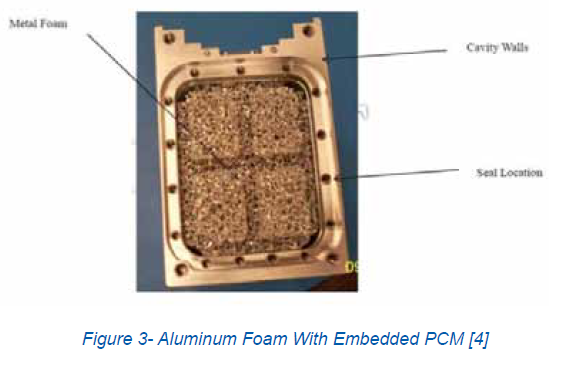
one of the drawbacks of using an encapsulated pcm is high price, which means that for now its use is limited to such demanding applications as cooling leds in outer space. however, future developments may see more widespread use of encapsulated pcms for energy storage uses as well as for thermal management [[5]].
another strategy to deal with the low thermal conductivity of the pcm is to embed a heat spreader within the pcm. fleischer, weinstein and kopec [3] used a heat sink made of carbon fiber and embedded it in the same volume discussed earlier. shown in figure 4 below, the conductivity of the heat sink is directional, and is 500 w/mk along the fin direction. that is approximately 25% better than copper, and other exotic materials such as graphite sheets could be excellent heat spreaders as well, promising thermal conductivities as high as 1500 w/mk [[6]].
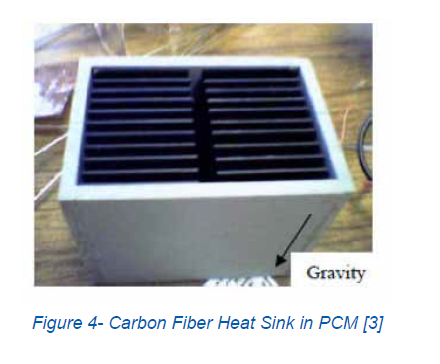
with 7w power again applied to the bottom of the volume, the effectiveness of the heat spreader is clear. the thermocouple temperatures show that the temperature throughout the volume of pcm is uniform (see figure 5), and well below the melt point at steady-state.
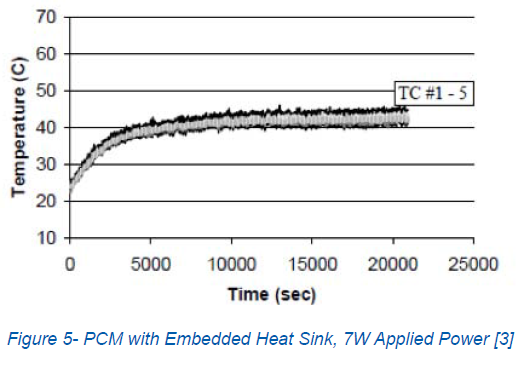
this represents an approximately 20ºc difference in steady-state temperature, which would greatly add to the longevity of electronics in a real-world application. the rate of temperature rise at the lowest thermocouple has also been reduced, indicating the heat spreader has improved the ability of the pcm to regulate temperatures during transient heat loads. other novel research in phase change materials is ongoing as well, and new applications of pcm in thermal management of electronics are expected to emerge within the next few years.
references:
[1]. “tpcm 580 series phase change material on laird technologies,” http://lairdtech.thomasnet.com/viewitems/phase-change-tims/tpcm-8482-580-series-phase-change-material?, [june 30, 2011].
[2]. wilson, j., (2005, may). “phase change material thermal properties,” electronics cooling. http://www.electronics-cooling.com/2005/05/phase-change-material-thermal-properties/ [jun. 15, 2011].
[3]. fleischer, a., weinstein, r., kopec, t., “analysis of transient thermal management characteristics of pcm with an embedded carbon fiber heat sink,” villanova university, pennsylvania, 2006.
[4]. bue, g., nguyen, h., keller, j., “analysis and design of phase change thermal control for light emitting diode (led) spacesuit helmet lights,” national aeronautics and space administration, texas, 2010.
[5]. zalba, b., marin, j., cabeza, l., mehling, h., “review on thermal energy storage with phase change: materials, heat transfer analysis and applications,” applied thermal engineering 23, 2003, pp. 251-283.
[6]. “kaneka electrical and electronic materials,” http://www.elecdiv.kaneka.co.jp/english/graphite/index.html, [jun. 20, 2011].
|